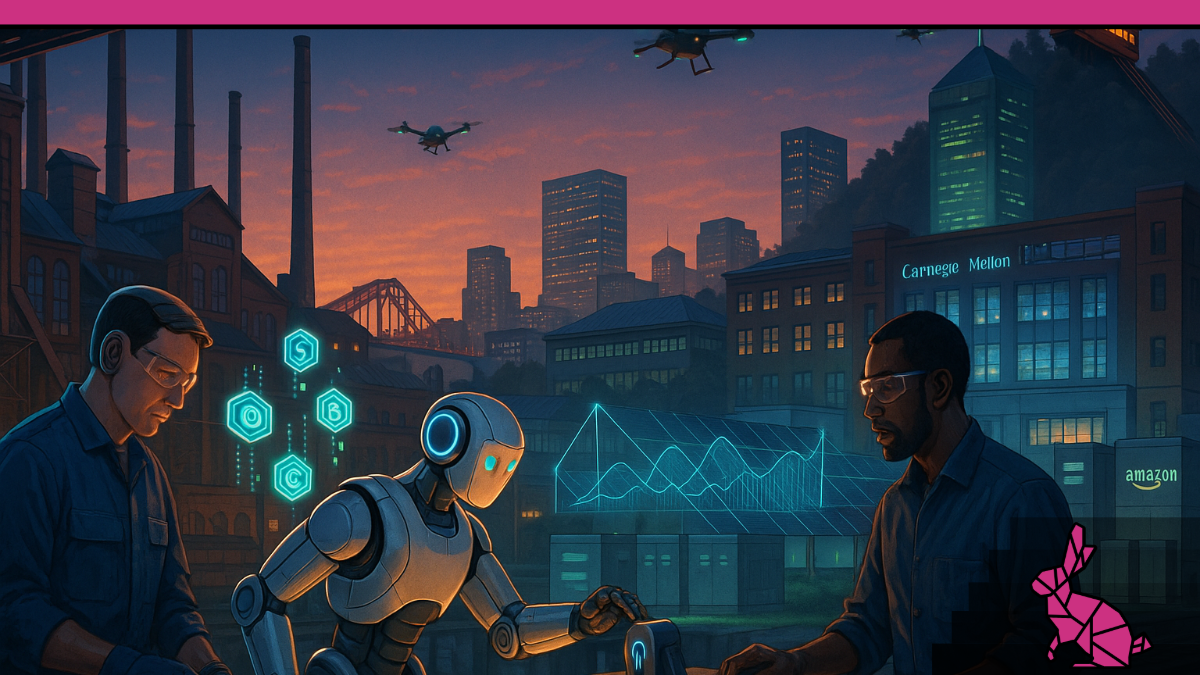We’re Entering The New Industrial Revolution
We’re entering The New Industrial Revolution—not powered by steam or steel mills, but by smart, even proto-sentient robots; decentralized ledgers; and clean, resilient energy. Nowhere is this transformation more visible than in Pittsburgh, where a $75 billion AI + energy infrastructure investment (announced July 15, 2025) is catalyzing new industries and human jobs. From Carnegie Mellon’s research labs to Amazon’s data centers, from the AI Strike Team to the Nippon Steel–U.S. Steel partnership, Pittsburgh is poised to become the world’s next AI hub.
1. Pittsburgh’s Robotics Renaissance
Carnegie Mellon University (CMU) has long been the cradle of robotics innovation, housing world-class labs in autonomous vehicles, humanoid robots, and computer vision. Today, CMU researchers are collaborating with the AI Strike Team—an industry consortium formed to shepherd Pittsburgh’s AI strategy—to spin out startups that build cobots capable of dynamic self-diagnosis and collaborative decision-making.
2. New Human Jobs Rising in Steel City
The surge of robotics and AI funding translates into hundreds of thousands of roles across the region. Key examples include:
Ethics auditors to oversee AI decision-making processes.
Collaboration coaches to facilitate human-robot teamwork.
Energy orchestrators to manage decentralized power grids.
Each position blends technical fluency—ethics, blockchain, energy systems—with Pittsburgh’s deep manufacturing and academic roots.
3. Crypto-Backed Trust in the Steel City
In the near future, when Pittsburgh’s robots begin “paying” each other for maintenance or data access, blockchain platforms developed at Carnegie Mellon University CyLab and piloted by AI Strike Team members could provide transparency with future applications such as:
Machine-to-Machine Micropayments: Cobots at the PPG Paints Arena use Ethereum-style smart contracts to settle energy fees with local microgrids.
Data Provenance Tokens: Sensor streams from U.S. Steel’s Mon Valley works are timestamped on private ledgers, ensuring every robotic adjustment is auditable.
These initiatives will rely on local firms + university spin-outs, and organizations like the AI Strike Team will help bring these ideas to market.
4. Energizing Pittsburgh’s Future
Pittsburgh’s legacy as an energy hub is being reborn with:
Decentralized Microgrids: The Hazelwood Green redevelopment is slated to include a renewable-energy “energy district” with solar + storage microgrid capabilities. The DOE’s NETL page lists Hazelwood Green as one of four Pittsburgh-area distributed-energy/microgrid projects currently in development. There may be potential for a partnership with CMU’s Wilton E. Scott Institute for Energy Innovation around AI + energy research.
Data-Center Power Optimization: Amazon Web Services (AWS) has committed $20 billion to expand PA data-center campuses, and AWS is investing heavily in renewable energy—solar farms, on-site solar, and nuclear partnerships. This could include co-development efforts with CMU’s PowerLab for fuel-cell backups or demand-response algorithms.
Steel-Mill Electrification: Nippon Steel Corporation and U.S. Steel have announced large-scale partnerships—reports cite roughly $14 billion of joint investments in modernizing U.S. steel infrastructure. This may include retrofitting blast furnaces with AI-managed electric arc technologies, reducing coal dependence.
These energy advances will ensure that robots—and the humans who build and manage them—operate on clean, resilient power.
5. Pittsburgh’s Human Advantage
Despite the march of autonomous systems, Pittsburgh’s brightest asset remains its people:
Cross-Sector Fluency: CMU students, U.S. Steel engineers, and Amazon technologists are co-located in innovation districts, fostering rapid knowledge exchange.
Responsible Innovation: The AI Strike Team’s governance framework—drafted alongside local unions and civic leaders—ensures equitable job growth.
Lifelong Learning Ecosystem: From community-college upskilling programs to CMU’s executive courses on AI ethics, Pittsburgh is equipping its workforce for continuous transformation.
Full List of Investors
Anthropic - $1 million
Blackstone - $25 billion
Brookfield - $3 billion
Capital Power - $3 billion
Constellation Energy - $2.4 billion
CoreWeave - $6 billion
Energy Capital Partners - $5 billion
Energy Innovation Center Infrastructure Academy
Enbridge - $1 billion
Equinor - $1.6 billion
First Energy - $15 billion
Frontier Group - $3.2 billion
GE Vernova - $100 million
Google
Homer City Redevelopment - $15 billion
Meta - $2.5 million
PA Data Center Partners and Powerhouse Data Centers - $15 billion
PPL Corporation - $6.8 billion
TC Energy - $400 million
Westinghouse Electric Company - $6 billion
Forging the Steel City of Tomorrow
With $75 billion in AI and energy investments, anchored by Carnegie Mellon University, Amazon, the AI Strike Team, and the Nippon Steel–U.S. Steel partnership, Pittsburgh is rewriting the playbook on industrial revolutions. New jobs such as ethics auditors, collaboration coaches, and energy orchestrators will define the next generation of human–machine collaboration.
By harnessing robotics, crypto, and clean energy, Pittsburgh proves that the New Industrial Revolution is not just about smarter machines, but about smarter people working alongside them.







